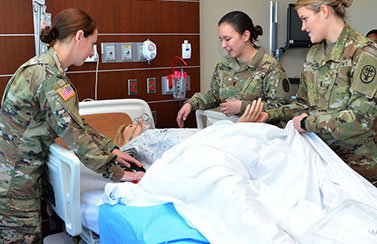THE PROBLEM
The brains of men and women are wired differently, in particular when it comes to traumatic brain injuries (TBI), with women more likely to develop subsequent neuropsychiatric disorders, like anxiety, depression, and post-traumatic stress disorder. Until now, it has been unclear as to why that is. Our laboratory examines how changes in how the body responds to exogenous psychological or physical stressors contribute to pathological conditions or if they provide evidence of it.
Our laboratory focuses on neuroendocrine mechanism(s) that are dysregulated when the body responds to external stressors. Classical neuroendocrine approaches are taken to determine how to promote warfighter resilience, prevention, or treatment of stress-related problems. We also examine how a stressful work environment alters the male and female neuroendocrine systems. Such an approach provides potential therapeutic targets to mitigate dysregulating stressors.
"The overall goal of the Wu laboratory is to determine the molecular and developmental regulation of neuroendocrine systems in order to promote warfighter resilience, prevention, and treatment of stress-related problems."
OUR APPROACH
In order to understand why blast brain injuries in particular have a different impact on men and women, we have conducted hormonal, behavioral, and anatomical studies measuring the integrity of the body’s major neuroendocrine system, the hypothalamic-pituitary-adrenal (HPA) axis. The laboratory has two ongoing pre-clinical research projects important to women’s health.
In the first project, we seek to examine why women and men respond differentially to stressful events by focusing on neuroendocrine mechanisms that are dysregulated when the body is exposed to external stressors such as traumatic brain injury, sleep disorders, and chronic stress. When exposed to chronic stress or traumatic events, women are more likely to develop certain neuropsychiatric disorders such as anxiety, depression, and post-traumatic stress disorder. The consequence of how exogenous psychological or physical stressors may contribute to pathological conditions remains unknown. Classical neuroendocrine approaches are taken to determine how to promote warfighter resilience, prevention, or treatment of stress-related problems. We are examining how exposure to stressors such as traumatic brain injury, photoperiod alterations, chronic stress and sleep disorders differentially affects females and males. Such a mechanistic approach provides understanding of dysregulation and the potential therapeutic targets to mitigate the impact of these stressors.
In the second project, we determine the functional role of two orphan G-protein coupled receptors (GPCR), GPR101 and GPR173. Understanding how these receptors function has potential to develop pharmacological tools to treat cancers, including gynecologic cancers. In this project, we focus on the role of gonadotropin-releasing hormone (GnRH) metabolite in regulating central and peripheral systems. We have found that a metabolite of GnRH, GnRH-(1-5), is bioactive and activates two orphan G-protein coupled receptors, GPR101 and GPR173 (Larco et al., 2018). These receptors have diverse functions including neuronal migration, cancer progression and regulation of growth. Studies in the laboratory are centered on the structure and function of these receptors.
RESULTS
In the first project, we have found that a mild TBI can disrupt the body’s neuroendocrine system, and that the alteration of stress hormones correlated with an increase in anxiety-like behavior in a sex-dependent manner. Every year, about 1.5 million individuals are diagnosed with TBI, and in the military, blast brain injury is the most prevalent as a result of explosive devices used in modern warfare. However, there are currently no therapeutic measures to mitigate the effects of subsequent neuropsychiatric disorders after a TBI. Our findings allow us to see how a mild TBI can disrupt the neuroendocrine system, and ultimately, we believe that uncovering the basic underlying neuroendocrine dysregulation will allow for better treatments.
In the second project, we have identified the ligand to two orphan GPCRs, GPR101 and GPR173. The identification of the ligand will accelerate our understanding of these GPCRs' role in function and in disease. Further basic understanding is crucial with the hope to generate novel therapeutics that target GPR101 and GPR173 activity and/or its effectors for the treatment of disease.


